Description of previous item
Description of next item
On the Border, Part II
Published May 5, 2015 by Florida Memory
This is the second installment of a two-part series on border disputes in Florida history. If you missed reading the first article, click here to read it.
In our first article on famous Florida border disputes, we looked at John Houston McIntosh, a borderland Floridian whose life reflected the tensions that sometimes cropped up along the Florida-Georgia border before Florida was a United States possession. Today, we look at an even more profound border conflict in Florida history, one that took almost a century to settle completely.
When the dust cleared after the American Revolution and the treaties were all signed, the newly created United States possessed the 13 former British colonies between Canada and the southern edge of Georgia. The Spanish obtained East and West Florida in a separate treaty with the British. That left just one problem: What was the legal boundary between Florida and Georgia? As the maps below demonstrate, it depended on who you asked.
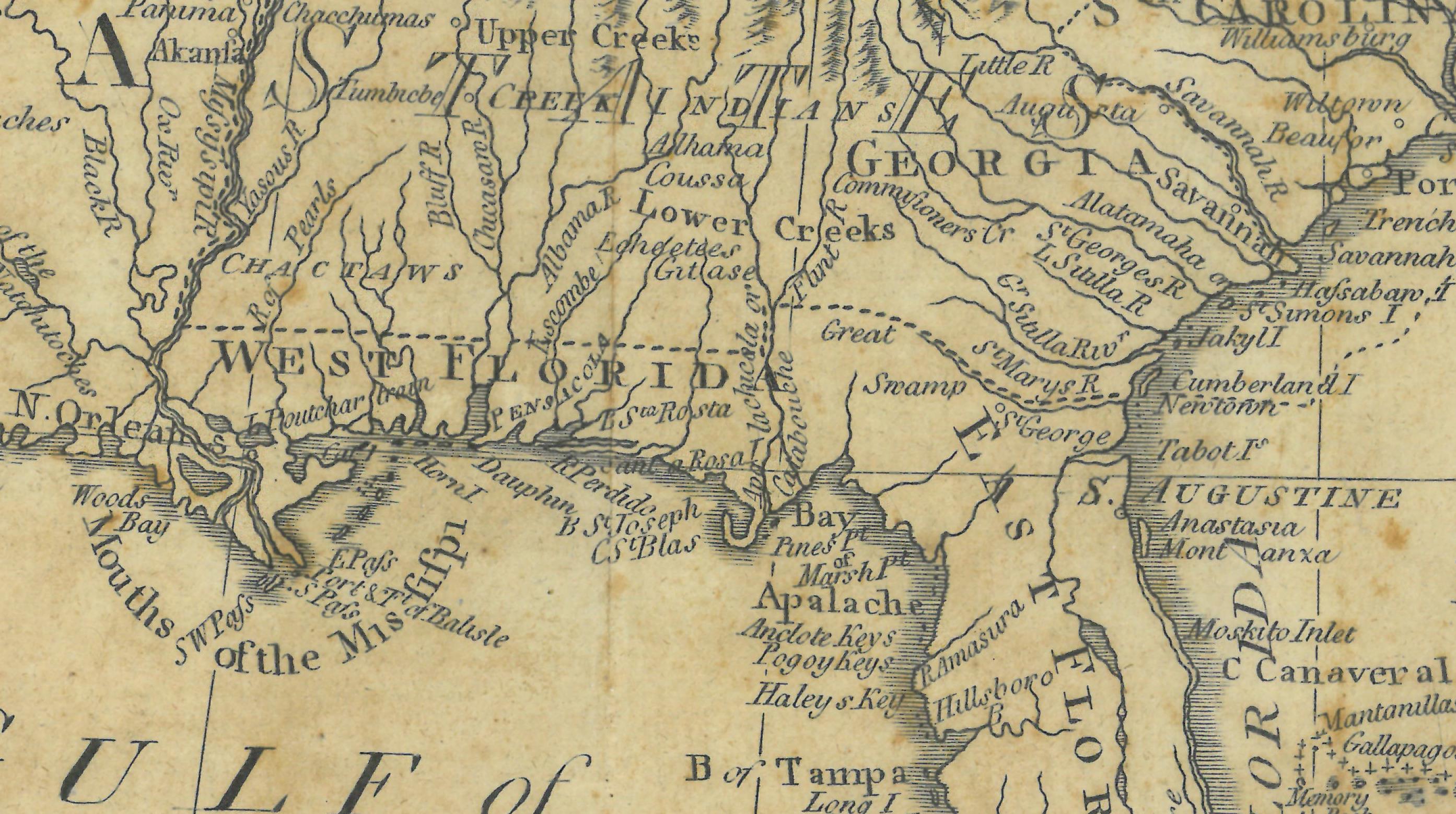
Excerpt from Thomas Bowen’s Map of North America (1780s). Florida Map Collection – State Library of Florida.
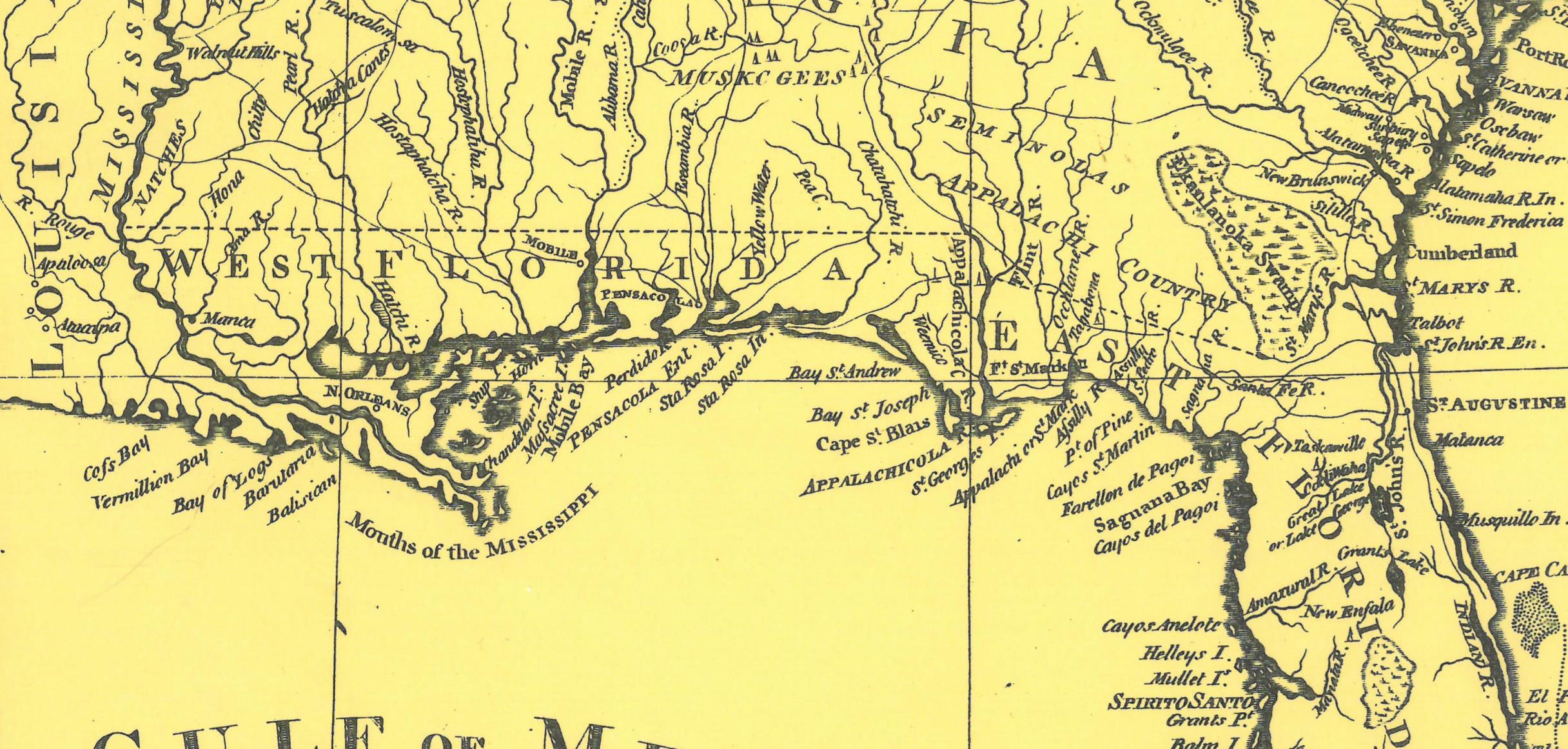
Excerpt from Joseph Purcell’s map of the Southern states, plus Spanish East and West Florida (1792). Florida Map Collection – State Library of Florida.
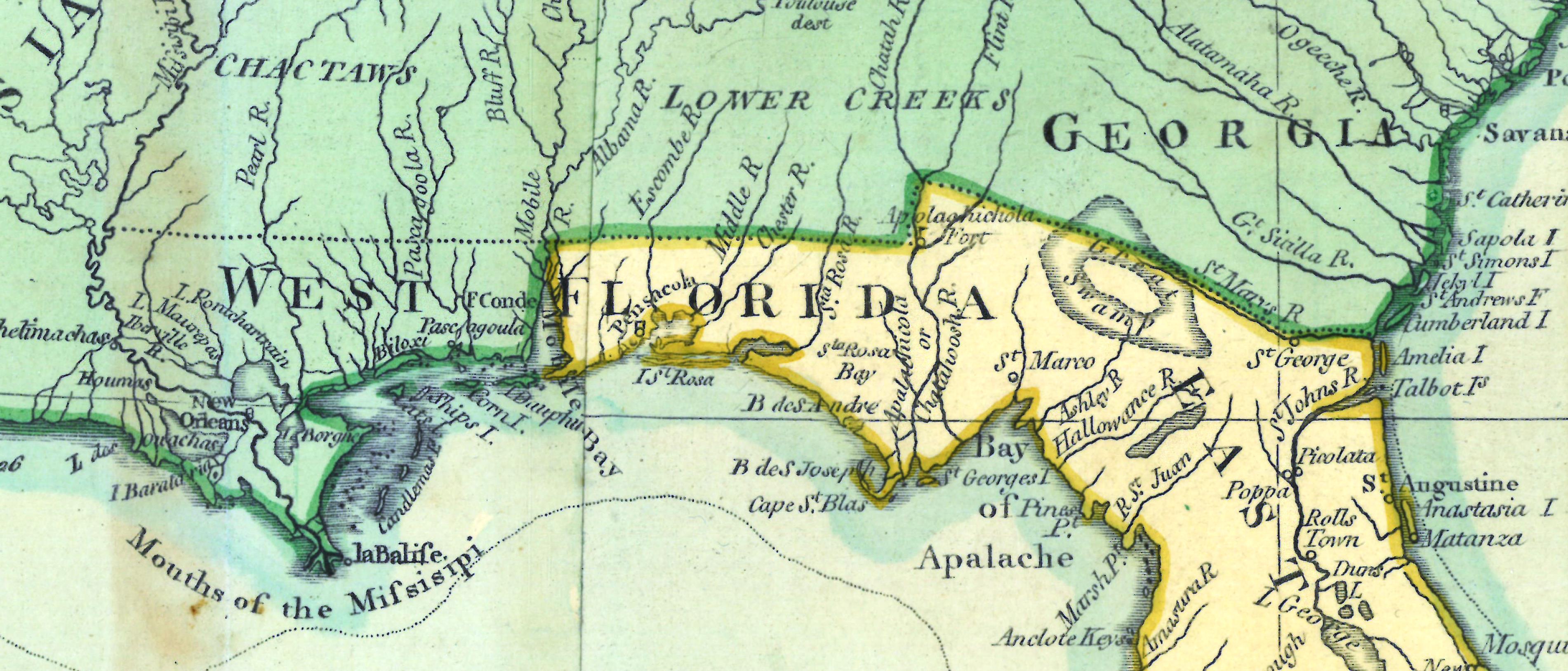
Jean Baptiste d’Anville’s “New and Complete Map of the West Indies” (1794). Florida Map Collection – State Library of Florida.
The mapmakers couldn’t agree, and neither could the statesmen. Considering how few people lived in the area at the time, it might not seem like such a big deal, but keep in mind that in those days the Florida-Georgia border was an international boundary line. Conflicts over the boundary continued between Spain and the United States, until finally the two countries agreed to settle their disputes by treaty. The Treaty of San Lorenzo, also sometimes called the Treaty of Madrid or Pinckney’s Treaty, stipulated that the two governments would appoint a joint commission to survey and mark the official border between Florida and Georgia.
Andrew Ellicott, a friend of Thomas Jefferson and a reputable surveyor and engineer, represented the U.S. on the commission. Captain Estevan Minor represented Spain. The two commissioners met at a point on the east bank of the Mississippi River below Natchez, where they were to begin their work. The Treaty of San Lorenzo called for the line to be surveyed out from the 31st parallel on the Mississippi east to the Chattahoochee River, down the Chattahoochee to its junction with the Flint River, then east to the source of the St. Marys River, then down the center of the St. Marys River to the Atlantic Ocean.
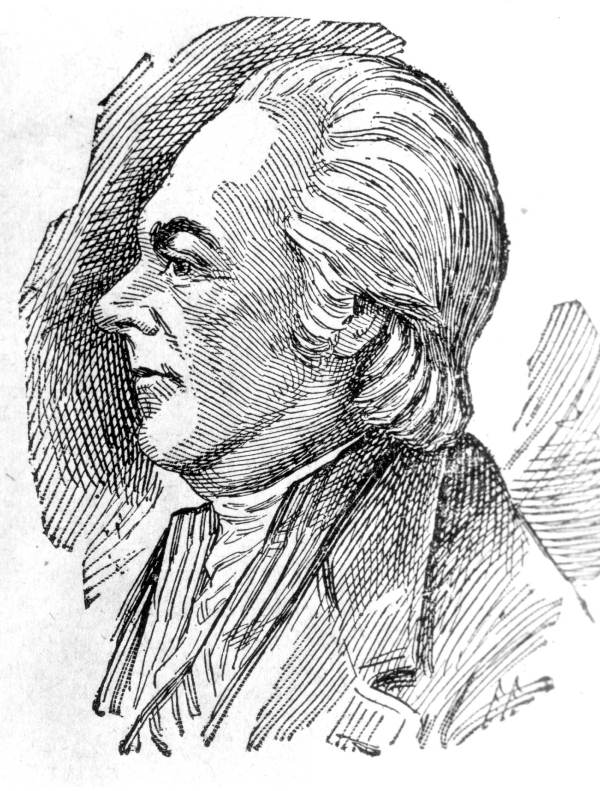
Drawn portrait of Andrew Ellicott, who represented the United States on the joint commission tasked with surveying out the boundary line separating Spanish Florida from the United States (circa 1800s).
Sounds simple enough, right? All the instructions were right there, nice and plain. Ellicott, Minor, and their assistants began their work in 1796 and continued surveying the line into the year 1800. When it was time to connect the line with the St. Marys River, the commissioners explored several of the river’s forks and finally agreed upon a point that would be considered the river’s “source,” as the treaty directed. Here, the surveyors erected a large hill of soil, later called Ellicott’s Mound. They determined the latitude and longitude of this location and were thereby able to calculate the correct placement of a line between the mound and the intersection of the Chattahoochee and Flint Rivers, which would be the Florida-Georgia boundary.
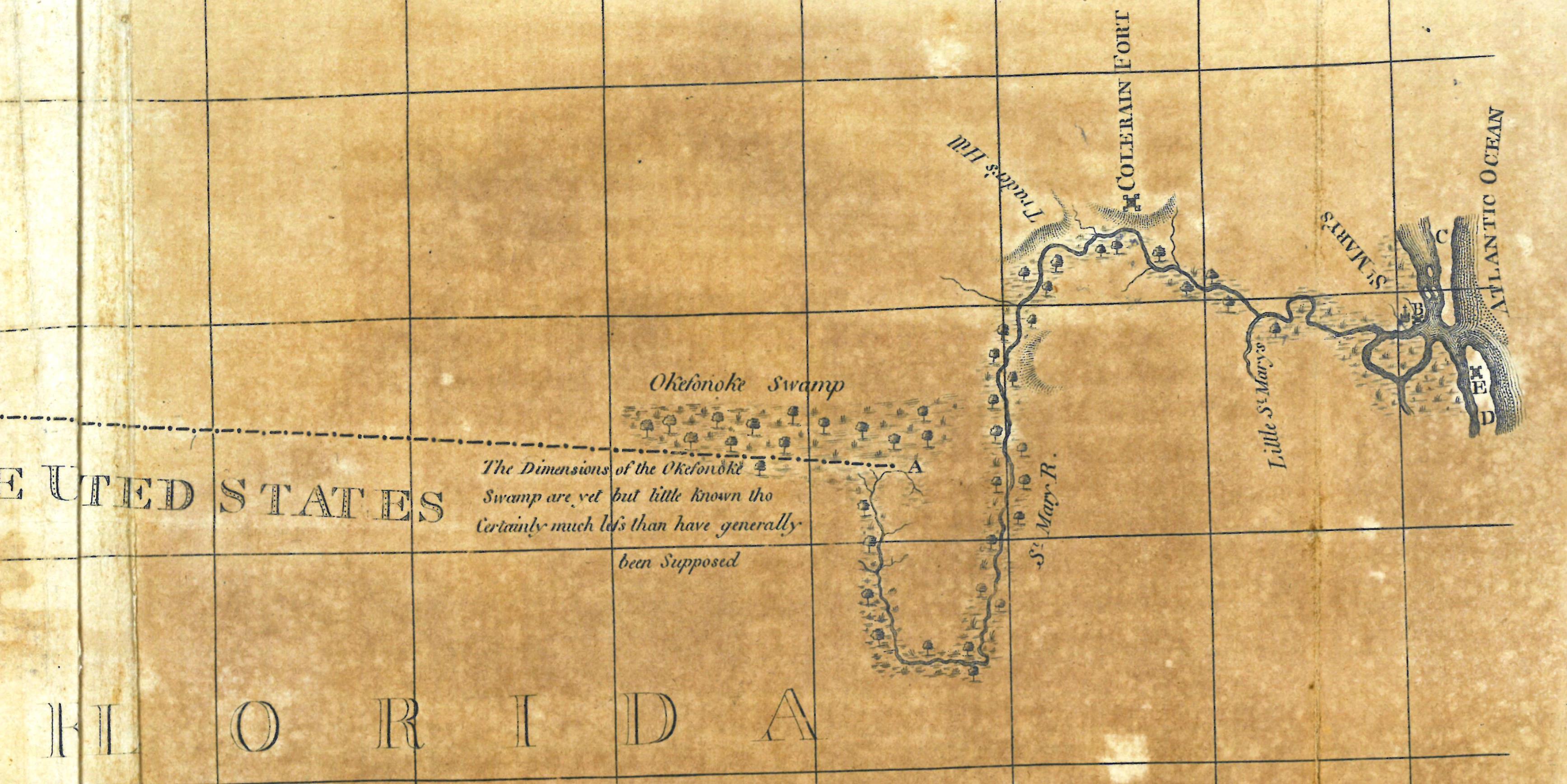
Excerpt of a map from Andrew Ellicott’s journal, showing the source of the St. Marys River (1803). The State Library of Florida holds an original printing of this journal.
Ironically enough, the placement of this line never proved a sticking point between Spain and the U.S. The real fireworks began once Florida and Georgia were both U.S. possessions. One of the first orders of business after Florida became a U.S. territory in 1821 was for the federal government to survey Florida out into townships and sections so the land could be distributed to settlers and local governments. To do this, however, the government surveyors needed to know exactly where the line separating Florida and Georgia truly was. Consequently, the United States Surveyor General arranged for the boundary to be clarified.
Meanwhile, in Georgia, some officials were beginning to doubt whether Ellicott’s Mound was located at the true source of the St. Marys River. Captain William Cone, a resident of Camden County who was familiar with the area, said the source of the river was actually located about 20-30 miles to the south. The state of Georgia appointed a commission to study this issue, as well as a surveyor named J.C. Watson to run, survey, and mark the proper line. When Watson finished his work, his line was not as far south as what Captain Cone had called for, but his line still ended south of Ellicott’s Mound. Georgia stood to gain a great deal of new territory by these findings, and state officials quickly extended county boundaries and state surveys to include it.
After several more rounds of conflicting surveys, Florida officials filed a bill of complaint with the United States Supreme Court, which is constitutionally charged with settling interstate boundary disputes. The suit never reached a final hearing. The state governments of Florida and Georgia ultimately ended up deciding the matter themselves. In 1857, both states agreed to use Ellicott’s Mound as the turning point for the boundary on the St. Marys River. A subsequent joint survey team worked out a line that everyone agreed upon, and the whole package was recognized and confirmed by an act of Congress in 1872. This settlement affected a number of land titles, of course, and these associated matters were eventually decided by the U.S. Supreme Court in 1887.
Florida and Georgia still have their differences from time to time, as adjoining states often do, but the southern boundary between them has all but ceased to be a matter for comment. The legacy of this near century-long disagreement is, however, still highly visible on state maps. You’ll recall that the land north of the Watson Line was claimed by Georgia all through the process of settling the dispute. By the time the controversy was settled, the land lying between the Watson Line and the real Florida-Georgia border had in many cases been sold and resold so many times that to re-survey it all into the Florida land system would have been very tedious. So, as a result, there is a strip of land across the top of the Sunshine State that belongs to Florida, yet is organized according to Georgia’s system of land description, as this map shows:

An excerpt from a map of Madison County published by the Florida Department of Transportation. The Watson Line is highlighted in red. Notice that the land between this line and the official Florida-Georgia line is not divided into the same system of townships and sections as the land farther south. Florida Map Collection – State Library of Florida.
Remember that the State Library and State Archives are excellent sources of information on all aspects of our state’s political history – even the obscure bits. We encourage you to visit info.florida.gov and search our catalogs to find more about your favorite topic in Florida history!
Cite This Article
Chicago Manual of Style
(17th Edition)Florida Memory. "On the Border, Part II." Floridiana, 2015. https://www.floridamemory.com/items/show/295248.
MLA
(9th Edition)Florida Memory. "On the Border, Part II." Floridiana, 2015, https://www.floridamemory.com/items/show/295248. Accessed February 26, 2025.
APA
(7th Edition)Florida Memory. (2015, May 5). On the Border, Part II. Floridiana. Retrieved from https://www.floridamemory.com/items/show/295248

 Listen: The Bluegrass & Old-Time Program
Listen: The Bluegrass & Old-Time Program